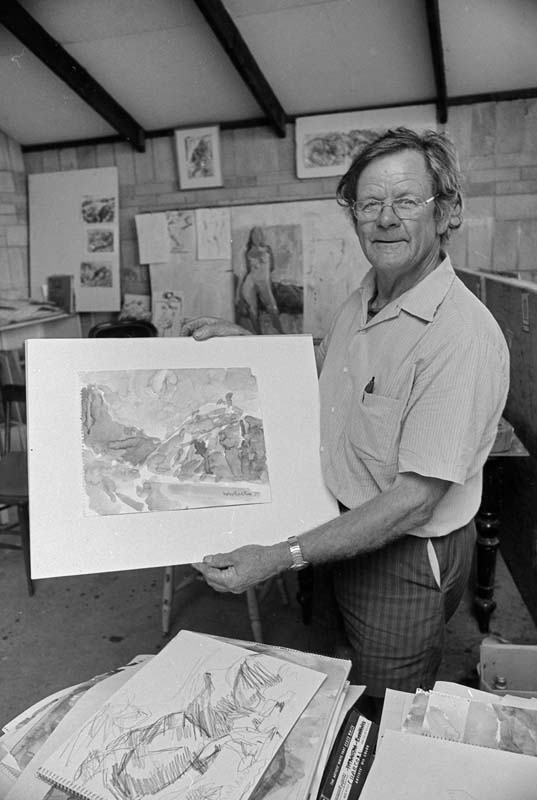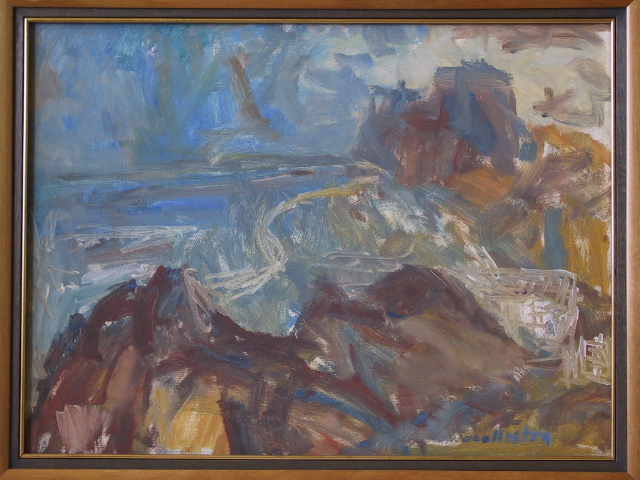Toss Woollaston
Years of hard work, talent, self-belief and the support of a good wife, all combined to make Nelson artist, Sir Tosswill Woollaston (Toss), one of New Zealand's best, and most prolific, landscape painters. But it was not easy.
Years of hard work, talent, self-belief and the support of a good wife, all combined to make Nelson artist, Sir Tosswill Woollaston (Toss), one of New Zealand's best, and most prolific, landscape painters. But it was not easy.
Woollaston was born in Taranaki in 1910, the eldest child of sharemilking dairy farmers. Charlotte and John Woollaston were God fearing and puritanical, and John, in particular, did not approve of his son's lack of inclination for farm work, or his desire to write poetry. However Woollaston was able to talk passionately with his mother about art, literature and religion and she helped him clarify his beliefs and ambitions.1
Aged 18, Woollaston, arrived in Nelson in 1928 to work on a Riwaka orchard. He joined the Nelson Suter Sketch Club (later the Nelson Suter Art Society)2 and began taking classes with Hugh Scott, who had two basic rules of painting : "one for oil and the other for watercolour- slap it on and slop it on," Woollaston recalled in Sage Tea.3
Scott advised Woollaston to attend the Canterbury College School of Art, which he did in 1931, assisted by a £5 21st birthday gift from his parents.4 He didn't like the rigid academicism, and moved South to spend two terms at art school in Dunedin, where he met his wife to be, Edith Alexander.5 He described Dunedin in 1932 as "the most artistically enlightened place in New Zealand."6
Painting was not regarded as a manly occupation at that time, especially in rural areas,7 but Woollaston's art was nourished by the countryside.8 Newly married, Edith and Toss returned to Māpua in 1936, where they settled in a primitive mud brick house, which Woollaston had previously built on his employer's property.9
Colin McCahon and Woollaston met in Dunedin. McCahon stayed with the Woollastons at Māpua, and he and his wife Anne lived in Nelson for some years in the 1940s.10 Both artists are credited with pioneering New Zealand modernism.11
By 1944, the Woollastons had four children under the age of seven.12 In November 1949, Woollaston accepted a Rawleigh dealership in Greymouth to help provide for his teenage family. He found little time for art in the 1950s and at one point became so exhausted and depressed that he considered giving it up.13
Woollaston struggled to make a living until the 1960s, when Wellington art dealer, Peter McLeavy began to sell his paintings. McLeavy's skilful promotion of his art over about 25 years saw Woollaston become firmly established at the forefront of modernist painting in New Zealand. 14 He was knighted for services to painting on November 10, 1979, when his former Dunedin art teacher, W.H. Allen, wrote to him: " You've had one good thing in your favour in your struggle - you picked the right wife." 15
Edith Woollaston, the rock in Woollaston's life, put aside her own artistic ambitions to raise a family and support her husband. An archive at the Museum of New Zealand contains about 200 of her drawings and watercolours dating from her teenage years to the 1970s.16 Edith died in 1987 after nearly 51 years of marriage. Woollaston said her role in his career was inestimable17 and he was glad she lived to enjoy the fruits of his success after the years of hardship.18
In 1989, Woollaston formed a relationship with former U.S. ambassador to New Zealand, Anne Martindell, and spent time in the U.S. 19 He died in the Upper Moutere, Nelson, in 1998.20
On his use of ‘muddy' colours, Woollaston wrote: "My own ultimately rather restricted range of dull earth colours and reduced blues and greens arose from my own personal response to the daytime earth colours of the sun-drenched landscape of Māpua....writers on my work are fond of quoting me as having said...I wanted to paint the light, but only after it had been absorbed into the earth. It is true." 21
Written with thanks to Philip Woollaston and the Toss Woollaston Trust, 2011
Updated February 2021
Story by: Joy Stephens
Sources
- Barnett, G. (1991) Toss Woollaston, Wellington, N.Z.: Random Century. p 15
- Barnett, p 16-19
- Woollaston, T. (1980) Sage Tea: an autobiography Auckland, N.Z.: Collins, p 197
- Woollaston, p 209
- Barnett, p19-20
- Woollaston, p231
- Shepard, D. (Ed.)(2005) Between the lives: partners in art Auckland, N.Z.: Auckland University Press, p 22
- Barnett, p 25
- Shepard, p 20
- Barnett, p 49
- Walrond, C. (2010) Nelson region - Arts, culture and science. Retrieved from: Te Ara - the Encyclopedia of New Zealand:
https://teara.govt.nz/en/nelson-region/page-14 - Barnett, p 49
- Shepard, p 25
- Stead, O. (2008) Art of New Zealand icons: lines in the sand. Auckland, N.Z. David Bateman, p 45
- Shepard, p 17
- Shepard, p 24
- Barnett, p 95
- Barnett, p 9
- Shepard, p 29
- Barnett, G (2010) Woollaston, Mountford Tosswill - Biography. In from the Dictionary of New Zealand Biography. Te Ara - the Encyclopedia of New Zealand
http://www.TeAra.govt.nz/en/biographies/5w49/1 - Pound, F. (2009) The invention of New Zealand: art & national identity, 1930-1970 Auckalnd N.Z.: Auckland University Press, p 54
Further Sources
Books
- Barnett, G. (1991) Toss Woollaston, Wellington, N.Z.: Random Century
http://www.worldcat.org/title/toss-woollaston/oclc/29598696&referer=brief_results - Pound, Francis (2009) The invention of New Zealand : art & national identity, 1930-1970 Auckland, N.Z. : Auckland University Press
http://www.worldcat.org/oclc/228368074 - Stead, Oliver (2008) Art of New Zealand icons : lines in the sand. Auckland, N.Z.: David Bateman, 2008.
http://www.worldcat.org/oclc/271580548 - Shepard, D. (Ed) (2005) Between the lives : partners in art Auckland, N.Z.: Auckland University Press.
http://www.worldcat.org/oclc/61114281 - Trevelyan, J. (2004) Toss Woollaston: a life in letters, Wellington, N.Z.:Te Papa Press
http://www.worldcat.org/title/toss-woollaston-a-life-in-letters/oclc/60517461 - Woollaston, Toss (1980) Sage tea: an autobiography. Auckland, N.Z. : Collins
http://www.worldcat.org/oclc/154644795 - Woollaston, M (1966) Erua, Auckland, N.Z.: Blackwood and Janet Paul
http://www.worldcat.org/title/erua/oclc/460784 - Woollaston, T. (1973) Woollaston works/1933-1973.{Palmerston North, N.Z.} : Manawatu Art Gallery
http://www.worldcat.org/oclc/980573
Newspapers
- Barnett, G. (1998). Remembering Toss. Art New Zealand, 89, 32-33
- Dekker, D.(1998, September 19) The ambassador and the artist. Nelson Mail, p. 9
- McAloon, W. (2005, January 22) The mountains across the Bay [book review]. New Zealand Listener,197, pp.42-43
- Manning, D. (1998, September 2) Faithful to his vision. Nelson Mail, p.9/11
- Reid, B. (1992, May 18) Unashamedly a man of the land. Time, pp.52-54
- Tributes pour in for Sir Tosswill (1998, August 31) Nelson Mail, p.1
Websites
- Barnett, G (2010) Woollaston, Mountford Tosswill - Biography. In from the Dictionary of New Zealand Biography. Te Ara - the Encyclopedia of New Zealand
http://www.TeAra.govt.nz/en/biographies/5w49/1 - Sir Toss Woollaston. Retrieved from the Suter Art Gallery, 31 March 2011
http://thesuter.org.nz/collection/sirtosswillwoollaston.aspx#39 - Toss Woollaston: family and friends. Te Papa: Museum of New Zealand exhibition, 2005:
https://www.tepapa.govt.nz/visit/whats-on/exhibitions/past-exhibitions/2004-past-exhibitions#Toss - Walrond, C. (2010) Nelson region - Arts, culture and science. Retrieved from: Te Ara - the Encyclopedia of New Zealand:
http://www.teara.govt.nz/en/nelson-region/14
Maps
- Suter Art Gallery, Nelson (http://thesuter.org.nz/) holds a representative collection of works by Sir Mountford Tosswill Woollaston KB (1919-1998)
- Toss Woollaston in his studio 1991 [photograph]
http://www.teara.govt.nz/en/perceptions-of-the-landscape/6/5

